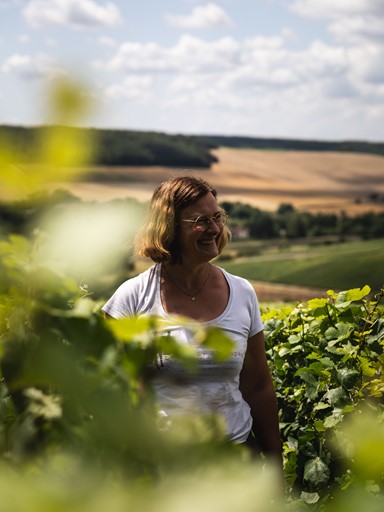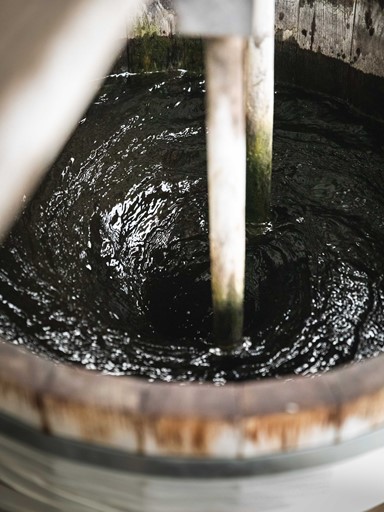
Demystifying Biodynamics
Francis Boulard & Fille
Getting our hands dirty with with Delphine Boulard...
As the UK’s leading importer of premium biodynamic wine we couldn’t be more thrilled that more winemakers all over the world are embracing biodynamic viticulture and more consumers are seeking out these wines. But ask most somms for details about biodynamics and they’ll likely shrug their shoulders at exactly how it works but acknowledge there is certainly a benefit to the vines and the wines. Even many winemakers know it is often regarded as a bit of science and a bit of wizardry, and thus leave the details out of their materials and interviews.
On a recent trip to Champagne, we visited both our biodynamic producers there and were overwhelmed with how eager they were to share the details of their practices. At Domaine Francis Boulard et Fille, Delphine Boulard proudly let us see, smell and touch her biodynamic preparations, and eagerly demonstrated exactly how she makes them. Thankfully we had our photographer on hand, so we decided the moment was right to create a bit of a primer on biodynamie.
Pioneers
Francis Boulard was one of the pioneers of biodynamic viticulture in Champagne. A sixth-generation grape grower, he first became interested in organic methods over 30 years ago. For his forefathers, cultivation was guided by nature and the rhythm of the seasons, and he thought a return to these practices just made sense. In 2009, he and his daughter Delphine broke away from the family domaine and founded their own organic and biodynamic estate.
Francis Boulard et Fille was part of the organic and biodynamic renaissance in Champagne, and was certified biodynamic in 2015. After Francis retired in 2016, Delphine took full control of the domaine and remains an enthusiastic promoter and diligent follower of biodynamic practices. From very beginning, working alongside her father, Delphine made all the preparations herself. She still does today, as she finds the practice calming and restorative, and feels it brings her closer to the life of the vines.

“Biodynamics sees things in terms of a flow of energy to encourage the life in and of the soils, which therefore will give high quality grapes. Naturally produced preparations vivify the soils and give the vines the natural elements they need to fight illness.”
- Delphine Boulard
Biodynamic Basics
There is a lot of misunderstanding about biodynamics, starting with how it differs from organic farming. Organic viticulture bans all pesticides or synthetic chemicals in the vineyard and uses only compost for fertiliser. Biodynamics shares these same principles, but goes deeper by using the ‘life force’ of Mother Nature to heal the land and grow nutrient-dense crops without the use of chemicals. The concept was developed by Austrian philosopher Rudolph Steiner nearly a century ago, as a holistic approach that fosters a connection between the farmer, soil, plants, animals and the cosmos. Biodynamics uses the guidance of an astronomical calendar for all activities and prescribes a system of life-affirming soil supplements. While it can apply to all types of farming, biodynamic winemakers insist their vines are stronger, more resistant to disease and pests, and their wines more flavourful and intense.
There are nine ‘preparations’, numbered 500-508, which are fundamental to the biodynamic way of farming. They are considered a remedy for the land, and promote optimal growth and quality. Plant, mineral and animal substances are combined and then returned to nature in a modified form – either as sprays or compost. The consistent use of these preparations is a requirement for any vineyard to be certified biodynamic by Demeter, the organisation which has regulated biodynamic farming since 1924.

“Biodynamics means listening to the vine when it needs it. It makes you rediscover the profession, the terroirs, the parcel identity and the nature that flourishes.”
Preparations
There are three field spray preparations (500, 501 & 508) which Delphine calls, “homeopathy for the soil.” They enhance the relationship between soil and plants and aid photosynthesis and ripening. To make these, a natural base material is stirred rhythmically in water using a dynamiser (pictured), which permits the ‘formative forces’ in each preparation to transfer to the water, and then later it's sprayed onto the vines using a vaporiser.
There are also six compost preparations (502 to 507) which are made from medicinal herbs like chamomile, stinging nettle and dandelion. Vineyard waste is composted and later returned to the land. The preparations are added in small quantities to the initial compost pile and again after it is turned. The preparations improve the quality of the compost by stabilising nitrogen and increasing microbial diversity. Research has shown that these preparations promote stronger, more robust plants with better resistance to pests and diseases.
The timing of when these preparations are used is determined by the lunar calendar. Since the gravitational force of the moon controls ocean tides, it stands to reason that the moon effects water in other ways too. Water is essential in both root systems and vines, so biodynamics times activities like planting, pruning and harvesting at ideal points in the cycles of water and sap movement. If this seems a little too new-age, even the 1818 Farmers’ Almanac stresses the value of farming in alignment with the phases of the moon.

Biodynamics at Francis Boulard et Fille
On our recent visit, Delphine proudly demonstrated the first biodynamic device the Boulard's bought – a dynamiser. We watched as the water was stirred slowly, starting from the edge, moving inwards to create a vortex. After a designated interval, the direction switches, breaking up the vortex and creating a new one in the opposite direction, generating different energy. While most dynamisers are made of copper, or occasionally stone, Delphine chose wood.
“The wood dynamiser has a different energy. It best suits my energy, and corresponds best to our systems and how we work… It switches the sense of direction on timed intervals, to break up the vortex and turn the energy.”
Delphine then showed us her preparations, letting us touch and feel and smell the base materials. She also shared her ‘recipes’ for her two key preparations:
Preparation 500 (cow manure in a horn)
High-quality manure is put into cow horns and buried during the winter. The manure undergoes a complete transformation and develops the texture and appearance of a soil– moist, colloidal in nature, odourless or with a slightly earthy smell. It enriches the soil and helps to strengthen the vine root systems and prevent diseases. For one hectare, 100g is dynamised with water for 20 minutes, then filtered. A vaporiser is then used to spray it onto vines, as soon as possible after stirring, usually in the evening.
Preparation 501 (silica)
This is the companion spray to preparation 500 and acts in polarity with it. It is not used on the soil, rather it works on the aerial parts of plants during their growth phase. Silica is considered as a sort of "spray of light" that promotes plant vigour and is vital for the internal structure of the vines. This is a very fine white powder, but has enormous energy, so the quantity must be very precise. Too much can lead to leaf damage in intense sun. For one hectare of vines, just 2g of the powder is dynamised in 120L of water for one hour, then sprayed in a fine mist, usually in the morning.
Timing is Everything
Delphine walked us through her monthly lunar calendar, a heavily dogeared tome filled with notations. The biodynamic calendar outlines cycles which guiding growers through root, leaf, flower, and fruit days which correspond to the four elements of earth, water, air, earth and fire. Each interval defines the time frame ideally suited for specific tasks both in the vineyard and the cellar. She also pulled out her phone to show us a biodynamic app she uses to track lunar changes alongside her own activities, make notes and set reminders that she can share it with the rest of the team. Much like her domaine and her wines, her management of biodynamics is blend of modern and historic that seems to be in ideal harmony.
Despite all the details and requisites, Delphine insists on a practical, not dogmatic approach. She says that integrating biodynamics into viticulture above all requires common sense. She first assesses what is happening around her and in the vines, and then makes decisions accordingly. Sometimes conditions mean the vines need extra attention, “For example, in great weather we use less silica, in rainy years we use more” she explains.

An Inspiration
Biodynamics aims to make each farm a self-sustaining living organism, which is undoubtedly better for the planet, the community, and according to Delphine, better for the winemaker too. And of course it also happens to lead to some amazing wines. The current low uptake of biodynamics in Champagne means there is little biodynamic bubbly on the market, and certainly very few handmade cuvées from small growers that are as impressive as the Francis Boulard wines.
Delphine’s passion for biodynamics is making some seriously compelling wines and likely inspiring generations to come...
View WinesWords by Allison Burton-Parker
Photography by Matt Hickman














